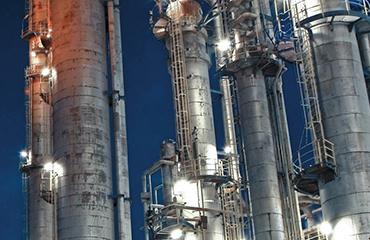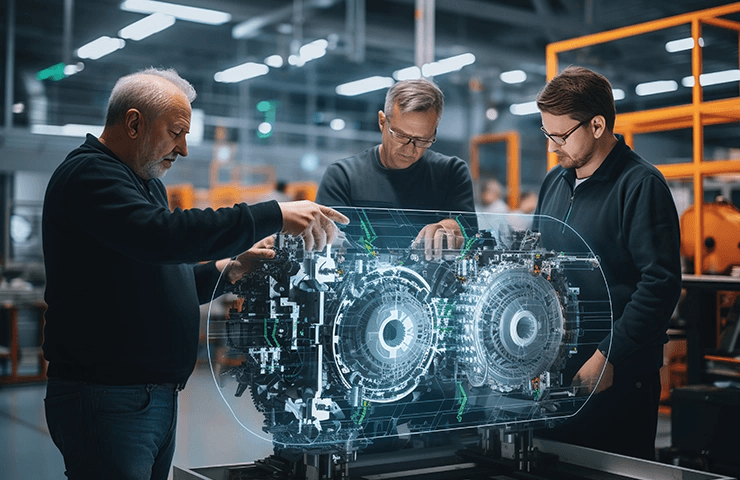
During downtime for revisions -- at, for example, refineries, power plants or steel mills -- no money is made, but rather money is spent. Through a modern shutdown management system, COSMO CONSULT TIC wants to make the most of the time when production has stopped by making the digital transformation of plant construction sites possible.
For technical facilities, there are legal requirements for revision measures at cyclical intervals. Due to the high level of availability of these facilities, the primary aim of which is production, there is a prevailing tendency to implement more revision measures in less time after longer and longer periods of time. Investments that are to be realized in a facility must be integrated into these periods if possible. "It's all about ensuring the highest availability of a facility or part of a facility on time and on budget with the maximum quality and safety", says Udo Ramin, managing director of COSMO CONSULT TIC GmbH in Magdeburg, when describing the objectives. On large projects such as refineries there can be 3,000 to 5,000 people working at a construction site, and they may belong to a variety of companies from the most diverse trades. This necessarily involves collaboration across company boundaries.
Detailed planning
Good shutdown management thus begins before the actual shutdown with detailed planning and preparation of all measures to be taken during the standstill phase. In recent years the focus was on this planning and preparation of the shutdowns, the improvement of the quality of planning and detailed digital engineering. So today people come to the construction site with well-planned high-end engineering but there they are disappointed by lack of continuity. This is because the construction site is not digitally connected to the engineering department. Everything that happens today at the construction site still happens on paper. This does not mean that the processing facilities have not been taken digital, because today they are most likely to have undergone digital transformation in the sense of “Industry 4.0”, as the trend to automation and data exchange in manufacturing is known in Germany. But this system is shut down for the revision period. Thus, only a traditional procedure remains, which is not digital for the most part. There is thus a huge potential for unproductive work time of 30-40%, because the technicians are blocked by non-productive times. The only solution here is: The digital construction site.
The digital construction site
Creating a digital construction site of course always requires that the corresponding internet technology is available on site. An important issue in recent years has generally been mobile feedback. On the construction site, this means bringing digital planning values from the engineering department to the construction site and making them available via the internet, so that the data is available on smartphones and tablets. The process of feedback would be accelerated by 25 percent just by doing that. Mobile assistance systems such as mobile work briefings or safety briefings instead of the traditional approach at the factory gate are extremely effective. The focus is also on logistics on construction sites. For example, imagine critical objects such as valves are to be dismantled, cleaned and later transported to the workshop. But imagine also that many construction cranes are positioned on that day in such a way that the transport is impeded. This inevitably leads to unplanned delays because there is no digital chain that lets you see where objects are, what state they are in, when they can be transported and when reassembled. Digital transformation also means that the site itself must be taken into the digital realm. Hardly anyone would go from one place to another without a navigation system in a private setting today. But you get only a paper copy of the site plan in an industrial park. A digital map, which visualizes the construction site and can differentiate between storage areas, hazardous areas and transport routes would make more sense. "Through the initiative we started with the Magdeburg Fraunhofer IFF two years ago, we have seen that there is vast potential for savings here", says Udo Ramin. Fraunhofer has surveyed some 400 companies in a potential analysis and learned that things are similar not only on large construction sites, but also in smaller projects such as industrial parks, and in the area of public infrastructure.
Core data on the go via apps
"We have presented our ideas about how the planning data is transferred from the engineering department to the construction site. On the other hand, real time information must come back from the construction site, for example, from logistics", continued Ramin. You have to keep track not only of the craftsmen doing the work, but also the objects they are working on, the equipment, the spare parts, the tools, the crane, the forklift truck, the vehicle. And you have to take the local infrastructure into account: roads, paths, surfaces, plant areas, and all that always linked with the technical structure of the respective facilities. It also became clear that people wanted simple digital tools such as smartphones and tablets. There should be small apps that provide access to all core data in digital form instead of today's flood of paper. There are different areas you can start from when setting up a digital construction site. First of all, for COSMO CONSULT the digital map was important to taking the construction site into the digital realm. The digital map allows scenarios to be planned ahead of time, and you can simulate them in ways not possible using traditional methods. In addition, this environment is predestined for cloud solutions. In turnaround you have a limited - short - period of time in which many external partners with a variety of different devices are involved. So it is useful to place everything in a limited-time cloud solution for the duration of the project. For example, we created a builders-contractors-suppliers portal in a web-based cloud environment, in our case an Azure-Cloud solution - that made support apps available for everyone working at the construction site. We put the planning data into the system and give the craftsmen access to it via tablet or smartphone apps”, says Udo Ramin describing this innovation. The portal can also be used to register all staff working on a project. Using the portal, those with access can authenticate themselves to obtain the corresponding data.
For projects both large and small
Furthermore, there is a focus on the provision of infrastructure. Therefore, out of the original initiative, a cooperation network was formed including companies such as Bosch and Microsoft in addition to COSMO CONSULT and the Magdeburg Fraunhofer IFF. New opportunities arise through the new loT technologies that are establishing themselves on the market. If you want to track a valve, a vehicle or a heat exchanger on a construction site, you need tracking technologies and technologies for the transmission of data. If you have thousands of objects in a project, the technology of Telekom or Vodafone is no longer sufficient. The objects can must be capable of transmission and in the most cost-efficient way. You cannot put a SIM card in every object. "We do not limit ourselves to the cloud solution, the digitization of maps and provision of assistance apps, but also take care of the infrastructure in order to get real-time data from the construction site", explains Ramin. Radio tags on objects are already being tested in operation at a medium-sized steel producer. The tags transmit time, temperature and location directly via the internet. The object trackers are already widely in use. The contractors portal has already been implemented at a refinery customer.
And the mobile safety instructions project is in the pilot phase. Even if the cooperation deals mainly with large projects, a standstill is in principle nothing more than a construction site within a plant construction project. For this reason, COSMO CONSULT has developed an SME platform, through which smaller projects in plant construction can be listed. There the building blocks of the large projects are linked with ERP functions. This makes the solution viable especially for many participating medium-sized companies. In summary Udo Ramin sure of this: "Engineering is largely digital today. The challenge is therefore above all in the digital transformation of the construction site and using that in shutdown management."
More similar news articles
Found what you were looking for?
Start your intelligent search now





